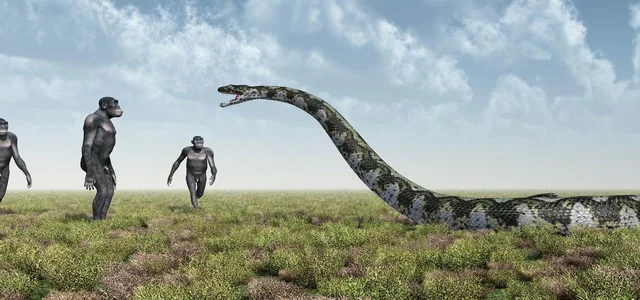
The recent discovery of fossilized remains of a fifty million year-old giant “madtsoiid” snake in western India has reinvigorated the debate surrounding the “world’s biggest ancient snake.” Using size estimation techniques based on a partially intact fossilized vertebral column, scientists who made the discovery deduce that the giant snake was approximately 35-50 feet long. To put this in perspective, the longest living snake is the reticulated python, found in southeast Asia, which can grow to just over 30 feet in length......Read The Full Article>>.....Read The Full Article>>
Length and girth, however, are two different things when it comes to sizing snakes. The biggest living snake by girth is the green anaconda, which can weigh well over 200 pounds, even though it tends to be slightly shorter than the reticulated python.
And, even though this newly discovered madtsoiid snake may be the longest ancient snake known to science, there’s good evidence to suggest that theTitanoboa, or “titan boa,” whose remains have been found in present-day Columbia, still reigns supreme as the world’s largest ancient snake by girth.
The authors of the new paper state that while the length estimates of the recent madtsoiid discovery exceed those of theTitanoboa, the size of the vertebral column of theTitanoboais bigger than the madtsoiid snake.
One thing is for sure: These ancient snakes were much larger than their present-day relatives. TheTitanoboa, for instance, is estimated to have exceeded weights of 2,000 pounds. Other extant animals in that weight range, for a point of comparison, include the hippopotamus, walrus and American bison.
Here are seven additional fascinating facts about the ancient and massive “titan boa.”
Time period. Titanoboa cerrejonensislived approximately 60 million years ago, during the Paleocene epoch, shortly after the mass extinction of the dinosaurs.
Habitat. Fossils ofTitanoboahave been found in what is now the Cerrejón Formation in Colombia, indicating it lived in a tropical environment with swampy forests and large rivers.
Adaptations for size. Its large size was likely a response to the warm climate of the Paleocene era, which allowed for a higher metabolism and supported the growth of such massive reptiles. Its body shape and structure were likely adapted to efficiently move and hunt in aquatic environments much like modern day anacondas.
Diet. Although there is no direct evidence from the fossil record of whatTitanoboaconsumed, it is speculated to have been a carnivorous predator, like all other snakes, feeding on a variety of animals including large fish, crocodilians and possibly even early mammals. Its size and strength would have allowed it to overpower and consume prey much larger than those of modern snakes.
Discovery. The first fossils ofTitanoboawere discovered in 2009 by a team led by researchers from the University of Florida. The discovery included numerous vertebrae and several incomplete skeletons, which provided valuable insights into its size and anatomy.
Implications for paleoclimate. The existence ofTitanoboahas also provided clues about the climate of the Paleocene era. The presence of such a large, cold-blooded predator suggests that temperatures in tropical regions were likely warmer than they are today, allowing for the growth and sustenance of such a massive reptile.
Family.Titanoboaexists in the “boid” family of snakes—a nonvenomous family of snakes found primarily in the Americas but also Africa, Europe, Asia and some Indo-Pacific islands. Boid snakes kill their prey via constriction, which is why they are among the biggest snakes in the world. The green anaconda, for instance, is in the boid snake family. The boa constrictor is also a member of the boid family. Most boid species are ovoviviparous, meaning females give birth to live offspring—unlike pythons, which lay eggs.
